Introduction
Judgment of facial esthetics is subjective and undoubtedly, depends on various culture, social, geographic and psychological background of person. An “excellent” face as constituted by soft tissue profile have been reproduced many time by representatives of several disciplines including artists, physical anthropologist reconstructive surgeon and orthodontists. These profile show large variation in skeletal convexity, soft tissue and lip protrusion, and position of the lower incisor. The inevitable conclusion is that great variation exists in what is considered a good to excellent face within a given culture
As far as orthodontics is concerned, harmonious facial aesthetics and functional occlusion have long been recognized as the two important goals of orthodontic treatment.[1],[2] Angle emphasized the importance of soft tissue and facial esthetics in orthodontic treatment. He believed that the harmony and the balance of the face depend largely on form[3]
Pioneers in Orthodontics have opened the way for racial studies and formulated cephalometric norms among different race and ethnic groups.[4],[5],[6],[7],[8],[9],[10],[11] Studies have also been carried out by many Indian authors on different racial and ethnic population found in the Indian subcontinent.[12],[13],[14],[15],[16],[17],[18] The conclusion of these studies stimulated the present investigation, as till date no study has been conducted on the population of Assam. It was therefore thought pertinent to undertake such a study for young adult population of Assam and observe various soft tissues cephalometric values by means of Holdaway’s analysis with a view to clinical application of the findings
The present study was carried out with the following aims and objectives:To compare the soft tissue traits of Assamese population with Holdaway’s cephalometric norms. To investigate the differences between the Holdaway’s soft tissue traits of Assamese men and women.Compare the Assamese soft tissue norms with soft tissue norms of other racial groups.
Materials And Method
The study was done from the data collected from lateral cephalograms of 70 adult Assamese subjects (35 males and 35 females) within the age group of 18-25 years in year 2011. Each cephalogram was traced twice and average value of each parameter was taken as the data.
Sample selected according to the following criteria
1) Subjects who had normal growth pattern, balanced facial profiles with competent lips and good facial symmetry determined clinically.
2) Subjects who had no history of Orthodontic or prosthodontic treatment.
3) Subjects who had full compliment of teeth (except third molars) with class 1 molar and canine relationship with good interdigitation of posterior teeth.
4) Subjects who had overjet and overbite relationship within the range of 2-4mm with crowding less than 3mm.
5) Subjects who had Orthognathic profile (class 1 skeletal pattern).
A Panel was formed comprising of
Dr Mitali Bora, Professor and HOD, Department of Orthodontics, Regional Dental College, Guwahati.
Dr Hitesh Baruah, Music Director and an Artiste associated with Assamese Film Industry.
Mrs. Runu Hazarika, Principal, My Fair Lady Training Centre and Advisor, Beauty and Fashion.
This Panel checked the samples required for the study and gave their consent regarding the fulfillment of the criteria of the samples, than lateral cephalograms of each subject were taken.
The head films were traced on acetate matt paper using 3H pencil. The tracings were analyzed using linear and angular measurements according to Holdaway’s soft tissue analysis to identify the soft tissue pattern. (Table 1) The angular measurements were done to an accuracy of 0.5 degrees and linear measurements were done to an accuracy of 0.5mm. (Images 1 to 4)
 | Figure 1 : Points Used In The Study
 |
 | Figure 2 : Planes And Angles Used In Study
 |
 | Figure 3 : Extraoral Photograph Of Female Assamese Subject
 |
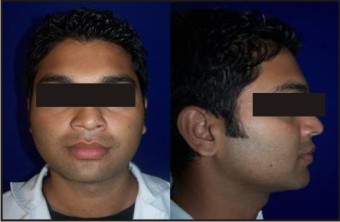 | Figure 4 : Extraoral Photograph Of Male Assamese Subject
 |
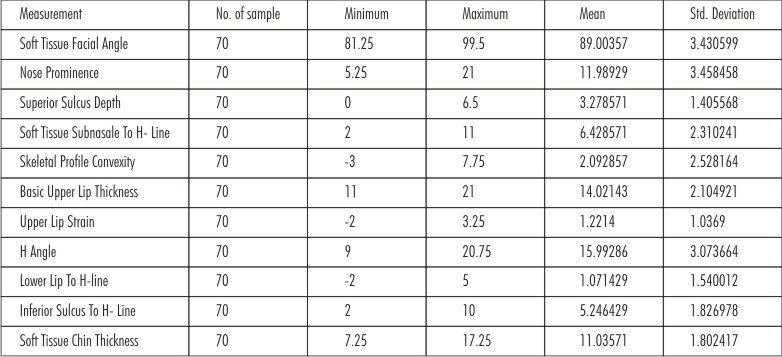 | Table 1 : Mean And Std. Deviation Of Cephalometric Measurements For Adult Assamese Population
 |
Results And Observation
The following result is obtained through the student’s ‘t’ test applied to compare the measurement differences of male and female. Table 2 shows the descriptive statistics of the male and female and the comparisons of the sex differences. In the comparison 4 variables had significant differences. In H angle (P <.0.03), basic upper lip thickness (P < 0.00), inferior sulcus to H line (P < 0.00), and soft tissue chin thickness (P <.0.00) measurements, statistically significant sex differences are found between Assamese male and female. The H angle, basic upper lip thickness, inferior sulcus to H line, soft tissue chin thickness, measurements of the male were larger than those of the female. Other parameter does not have statistically significant difference (Table 3, 4, 5).
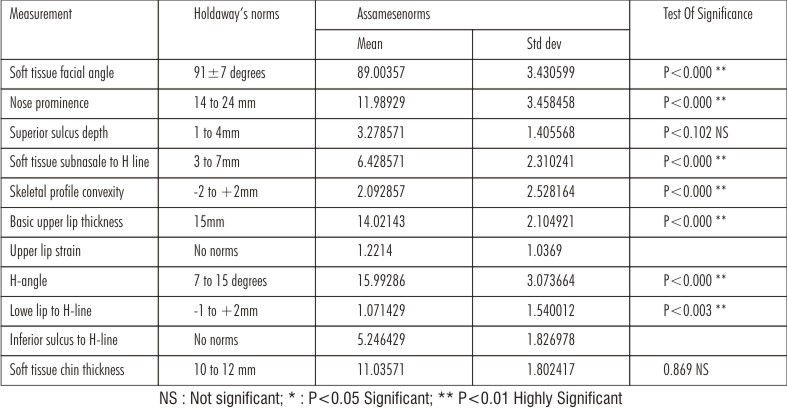 | Table 2 : Comparison Of Assamese Norms With The Holdaway’s Norms
 |
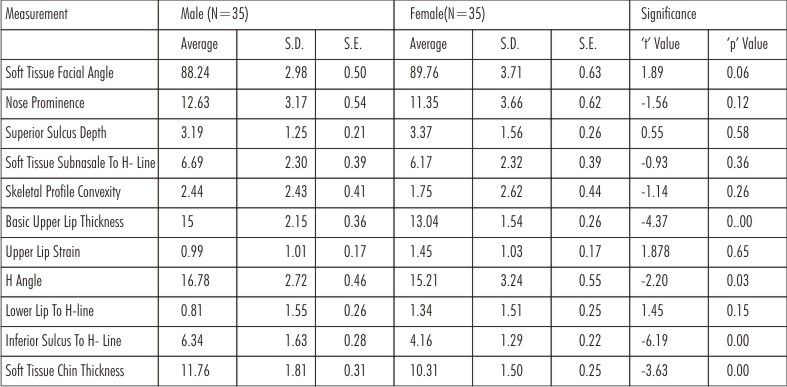 | Table 3 : Comparison Of Mean, Standard Deviation And Standard Error Of Cephalometric Measurements Between Males And Females
 |
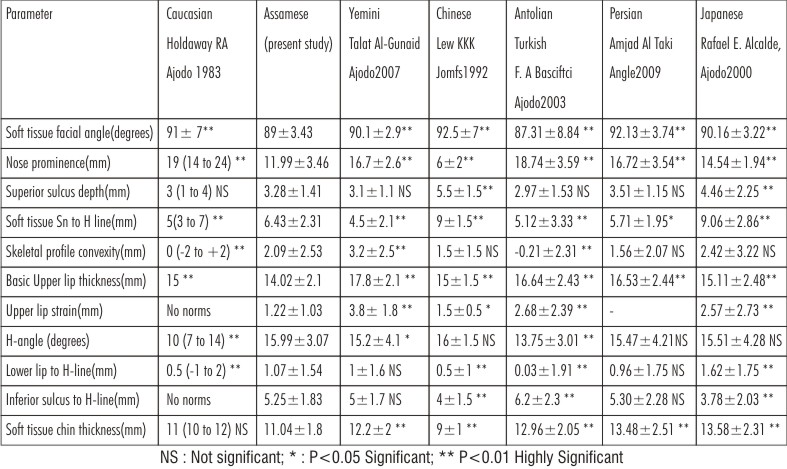 | Table 4 : Comparison Of Assamese Norms With Different Racial’s Norms
 |
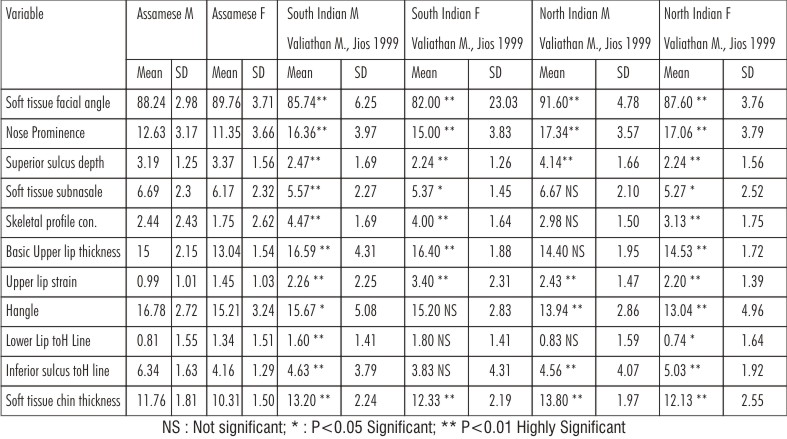 | Table 5 : Comparison Of Male And Female Assamese, North Indian And South Indian Holdaway Analysis.
 |
Discussion
In this comparison most of the values showed highly significant variations. The soft tissue profile of these subjects was found to be more protrusive when compared to the Caucasian subjects, as indicated by the highly significant increase in the H angle.
A similar cephelometric study was done by Dr.Nabanita Baruah et al19, on the Assamese population toestablish skeletal & dental parameters for Assamese young adults using Steiner’s analysis.The study concluded that in comparison to the Caucasian samples the Assamese samples were more protrusive skeletally and dentally with a greater tendency towards bimaxillary protrusion. These differences indicate that fundamental variation exists in the craniofacial structure of Assamese and the Caucasians. The results of the study support the fact that norms and standards of one racial group could not be used without modification for other racial group and each different racial group would have to be treated according to its individual characteristics.
Although the Holdaway’s analysis contributes towards successful treatment planning in Caucasian population, studies of other races have indicated that these standards are different enough to warrant closer evaluation. Indian profile has considerable variability and should not be treated with an Orthognathic profile in mind. Studies by many Indian pioneers in Orthodontics have shown that north Indian population and south Indian population has considerable variability.[12], [13], [14], [15], [16], [17], [18]
This study provides Holdaway’s cephalometric norms for adult Assamesepopulation from a selected sample of adult Assamese. The cephalometric measurements obtained from this study will be of value in the development of proportionate templates for the Assamesepopulation. This would provide a baseline aid for the diagnosis, treatment planning and prognosis for orthodontic cases. These analyses included the following linear and angular measurements - nose prominence, superior sulcus depth, soft tissue subnasale to H line, skeletal convexity, upper lip thickness, upper lip strain, lower lip to H line, inferior sulcus to H line and soft tissue chin thickness. Angular measurements were soft tissue facial angle and H angle. Small sex differences and modest signs of sexual dimorphism are obtained in Assamesemale and female. When linear and angular measurements are compared with Caucasian adults, ethnic differences in the skeletal and soft tissue component are noted. The limitation of this study was its sample size which is very less for a population study.
Soft tissue facial angle
The mean of soft tissue facial angle established for the Assamese population is 89 degrees and standard deviation of 3.43 degrees. The mean value for Assamesepopulation is less then Caucasian Holdaway’s norms (mean 91degrees andstandard deviation 7degrees).Thishighly significant statistical differenceindicates that chin is slightly more prominent in Caucasian than Assamese.
Nose Prominence
The mean of nose prominence established for Assamesepopulation is 11.99mmand a standard deviation of 3.46 mm. According to Holdaway, for nose prominence he has given a range of 14mm to 24mm as mean value, less than 14mm is considered to be small and above 24mm is large or prominent range8 In Assamesepopulation nose prominence is 11.99mmand a standard deviation of 3.46 mm, which is found to be smaller when compared to Caucasian, Yemini, Antolian Turkish, Persian and Japanese norms and higher than Chinese samples.
Soft tissue subnasale to H line
The mean of soft tissue subnasale to H line is 6.43mm with standard deviation of 2.31mm for Assamesepopulation. The measurement of soft tissue subnasale to H line has an acceptable range of 3 to 7mm, with 5 mm being ideal. In Assamesepopulation, soft tissue subnasale to H line is more than Caucasian and shows highly significant statistical difference.
Skeletal profile convexity
The mean of skeletal profile convexity at point A is 2.09mm with a standard deviation of 2.53mmfor Assamesepopulation. According to Holdaway, skeletal profile convexity has an acceptable range of -2 to 2 mm, with 0mm as ideal. Skeletal profile convexity shows significant statistical difference, which is suggestive of a protrusive profile in Assamese as compared to Caucasian.
Basic upper lip thickness
This measurement is useful in comparing the lip thickness near the base of alveolar process, measured about 3mm below point A to the outer drape of upper lip. In Assamesepopulation though the basic upper lip thickness was slightly smaller than the Caucasian, yet the subjects had an esthetic profile. The mean of basic upper lip thickness in Assamesepopulation is 14.02mm with a standard deviationof 2.1mm. In Assamesepopulation the basic upper lip thickness is found to be less compared to Caucasian population (15mm), and it shows highly significant statistical significance.
H angle
The mean of H angle in Assamesepopulation is 15.99 degree and standard deviation is 3.07 degrees. Holdaway said H angle measurement of 7 to 15 degrees were all in the best range as dictated by the patient’s skeletal convexity. 10 degrees is ideal when the convexity measurement is 0 mm. This study showed highly significant statistical difference, higher H angle which is suggestive of a protrusive profile in Assamese when compared to Caucasian.
Conclusion
The following results were apparent:-
1. Holdaway’s soft tissue Cephalometric norms for Assamesepopulation were significantly different than that of Caucasian population.
2. Soft tissue pattern of the Assamesepopulation was found to be protrusive, when compared to standard Caucasian population, as indicated by an significant increase in the values of H angle, skeletal profile convexity soft tissue subnasale to H lineand lower lip to H-linewith smaller soft tissue facial angle and nose prominence. However balanced and harmonious arrangement between the size of the nose, lips and chin contribute to a balanced facial appearance that is pleasing to the eye.
3. The Assamesemales and females showed almost similar facial profile with small sex differences and modest signs of sexual dimorphism with significant increase in basic upper lip thickness, H angle, inferior sulcus to H line and soft tissue chin thickness in males.
4. On comparison values of Assamese population with norms of other racial group, most of the values showed highly significant variations, which indicated that these standards are different enough to have separatecephalometric norms for different racial groups.
References
1. Merrifield L.L. The profile line as an aid in critically evaluating facial esthetics. Am J Orthod: 1966; 52(11)804-822.
2. Nick H. Cox and Frans P.G.M. Van der Linden. Facial harmony. Am J Orthod: 1971; 60(2)175-183
3. Angle E H. Treatment of malocclusion. Philadelphia: SS White manufacturing 7th ed.
4. Drummond RA. A determination of cephalometric norms for the Negro race. Am J Orthod: 1968; 54:670-82.
5. Fonseca and Klein WD. A cephalometric evaluation of American Negro woman. Am J Orthod: 1978; 73:152-60.
6. Cotton WN, Takano WS, Wong W. Down’s analysis applied to three other ethnic groups. Angle Orthod: 1951; 21:213-20.
7. Richardson RE, Racial differences in dimensional traits of the human face. Angle Orthod: 1980; 50:301-11.
8. Bakon W, Girardin P, Turlet JC. A comparison of cephalometric norms for the African Bantu and a Caucasoid population. Eur J Orthod: 1983; 5:233-40.
9. Shalbhoub SY, Sahan OA, Shake HS. Adult cephalometric norms for Saudi Arabians with a comparison of values for Saudi and North American Caucasians. Br J Orthod: 1987; 14:273-9.
10. Kapila S. Selected cephalometric angular norms in Kikuyu children. Angle Orthod: 1989; 59:139-44.
11. Huanng HS, Kim WS, MacNamara JA. Ethnic differences in the soft tissue profile of Korean and European-American adults with normal occlusion and well balanced faces. Angle Orthod: 2002; 72:72-80.
12. Nanda R, Nanda RS. Cephalometric study of the dentofacial complex of North Indians. Angle Orthod: 1969; 39: 23-8.
13. Valiathan A, and John KK. Soft tissue cephalometric analysis of adults from Kerala. J.Ind.Dent.Asso: 1984:56:419-422.
14. Sidhu SS, Sundaram KR. A cephalometric profile of Aryo Dravidans. Part 11. J. Ind. Orthod. Soc: 1989:20:90-94.
15. Grewal H, Sidhu, Kharbanda OP. A cephalometric appraisal of the craniofacial pattern in Indo- Aryans. J. Ind. Orthod. Soc: 1995:26:43-48.
16. Kapoor DN. “Indian cephalometric norms” published by Indian Orthodontic Society, CMC Hospital, Vellore.
17. Mengi G. “Indian cephalometric norms” published by Indian Orthodontic Society, CMC Hospital, Vellore.
18. Haridas R. “Indian cephalometric norms” published by Indian Orthodontic Society, CMC Hospital, Vellore.
19. Nabanita Baruah, MitaliBora “Cephalometric evaluation based on Steiners Analysis on young adults of Assam”. The Journal ofIndian Orthodontic Society. Volume 43, Number 1 January - March, 2009.
|